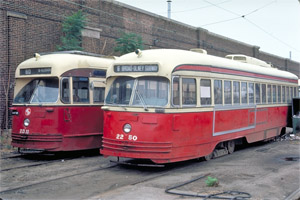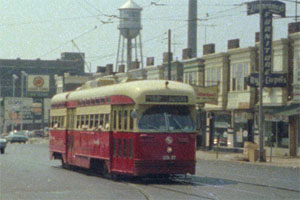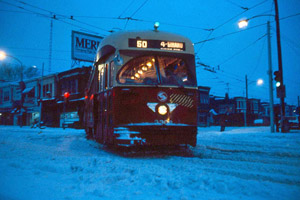SEPTA buys used PCCs from Toronto
Note: Click on the photos to see
enlargements with captions.
Thirty PCCs Bought to Relieve Car Shortage
By Rev. E. Casey
SEPTA buys used PCCs from Toronto
Note: Click on the photos to see
enlargements with captions.
Thirty PCCs Bought to Relieve Car Shortage
By Rev. E. Casey
The thirty used PCC cars that SEPTA
purchased from Toronto Transit Commission in 1976 were bought for a negotiated
price of $12,500 as is, where is. The total cost of the purchase was $375,000.
The cars had been built in 1946: eleven ex-Kansas City cars built by St. Louis
Car Co., and nineteen ex-Birmingham cars built by Pullman-Standard. Both fleets
remained in passenger service in Toronto right up until the time they were about
to be shipped to Philadelphia. 
After being taken out of service, the trucks (wheel assemblies) under the cars were re-gauged by TTC crews at Hillcrest Shops from Toronto gauge (4' 10-7/8") to SEPTA gauge (5' 2-1/4"). Cost of reguaging and shipping came to about $4000 each.
At Hillcrest Shops, the cars were placed on unpowered dummy trucks, and pushed up onto Canadian Pacific flatcars using a specially built ramp. The re-guaged trucks were placed on the flat car along with the trolley. The cars were shipped in ten groups of three cars each.
The first shipment left Toronto on March 15, 1976 and consisted of ex-Birmingham 4731, and ex-Kansas City 4750 and 4762.
This first shipment was unloaded
on March 23 at the Penn Central freight yards at 51st and Columbia in West Philadelphia,
then lifted by crane onto a flat-bed trailer truck. They were hauled to Callowhill
Depot where the cars were put onto the re-gauged trucks. The cars were then
operated the eight miles over city streets to Luzerne Depot to be readied for
service. 
The second batch of 4711, 4742 and 4772 departed Hillcrest Shops on April 12. This process continued through the summer and fall until the last cars were shipped on November 22, 1976.
When the cars went into service in Philadelphia, they remained in TTC colors. Only the numbers were changed, the TTC shield painted over, and the SEPTA logo applied. The glass windows were changed in favor of unbreakable lexan, which was being installed on all SEPTA GOH (general overhauled) PCC cars at the time. The unique blue glass that had been specified for the upper sashes of the ex-Kansas City cars' rear-quarter windows when they were built in 1946 was removed and replaced with clear lexan, too.
The decision was made to use the
ex-TTC cars exclusively on Route 60 Allegheny Avenue, at least at first. The
reasoning was that the passengers on the line would get used to the same cars
each day. It was noted that the front doors would clear the numerous traffic
safety island loading areas. 
Track switch operation would prove to be a problem, and was another reason why Route 60 was chosen for the ex-TTC cars. Toronto had a unique "necessary action" format for track switches. This would not be compatible with Philadelphia's system, and therefore track switches could not be operated electrically. Switches would need to be thrown manually by the operator, who would stop the car, get out and move the switch point with a switch-iron. It was thought that Route 60 would be the best route for having to do this. Other than Richmond and Westmoreland Loop, the only location where a switch would have to be thrown with any regularity would be Richmond and Allegheny, where Routes 15 and 60 diverge.
In 1976, trolley cars on the SEPTA system were equipped with wheels at the tops of the trolley poles to collect power. The Toronto cars arrived with slider-shoes on the poles instead of wheels, and it was decided to retain sliders on the cars as an experiment. Later in 1976 it was decided to convert all SEPTA surface rail vehicles to the slider-shoe type of power collection. After the overhead wire fittings were changed over for slider operation, Luzerne PCCs received sliders during the summer of 1976. Route 23 was the first line to be totally changed over to trolley slider-shoe operation. It it was not until 1980 that Woodland and Callowhill cars had their trolley pole wheels replaces with shoes.
Toronto winters tend to be longer and harsher than those in Philadelphia, and the condition of the steel frames beneath the ex-TTC PCCs reflected this. Decades of operation on streets consistently treated with road-salt resulted in severe corrosion, including frames with holes eaten completely through. In comparision, Philadelphia PCCs frames were in better condition, and this was immediately obvious when an ex-TTC and an original Philadelphia PCC were placed on adjacent tracks over the Luzerne Depot inspection pits.
Another problem with both series of Toronto cars operating Philadelphia was the TTC wheel profile. TTC wheels had wider tread and a deeper flange than the original Philadelphia cars, and this reduced the effectiveness of the cars. This was especially true on streets like Allegheny Avenue, which had some of the worst track on the SEPTA system at the time.
The ex-Kansas City ex-TTC 2200s were eventually painted in the SEPTA "Gulf Oil" orange-white-and-blue paint scheme. No ex-Birmingham cars were ever painted in SEPTA colors. Those cars stayed in TTC red during their brief stay at SEPTA, with at least one car (2304) receiving a fresh coat of red and cream paint at SEPTA's Courtland Shop. By 1982 the last of the ex-Birmingham cars was removed from service and scrapped. A handful of the ex-Kansas City ex-TTC cars survived until the following year, rolling to a final stop in 1983.
Click
here to view a roster of the eleven ex-TTC ex-Kansas City cars,
and here to view a roster of the nineteen ex-TTC ex-Birmingham cars.
